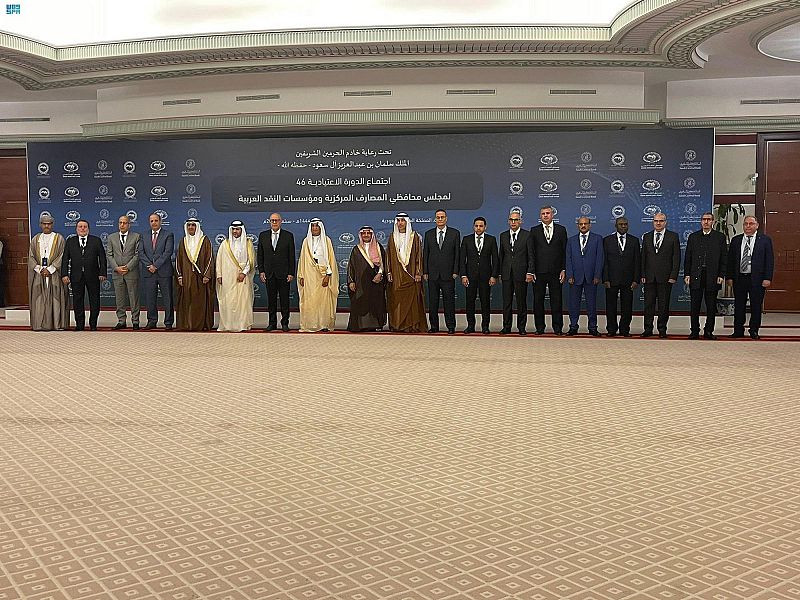The meeting of the forty-sixth regular session of the Council of Governors of Arab Central Banks and Monetary Institutions discusses the repercussions of the global inflationary wave, the risks of the repercussions of climate change on the financial sectors, and the challenges facing the banking sector in the wake of lifting support packages, in addition to Central bank digital currencies.
The meeting, hosted by Saudi Arabia, was launched on Sunday and continues today.
It witnessed the participation of a number of senior officials of the International Monetary Fund and the Financial Stability Board, as well as experts from international institutions and global central banks.
In the opening session, the Governor of the Central Bank of Egypt, Dr. Fahd bin Abdullah Al Mubarak, said in a speech that the meeting corresponds to an important stage of economic developments, reforms, and development plans, in addition to the political turning points facing the entire world, and the repercussions on various economic, financial and monetary aspects. These developments went alongside the economic recovery following the Corona pandemic, which benefitted from government efforts to address the pandemic through stimulus packages and direct support, and strengthened economic recovery.
About the Saudi economy
Al-Mubarak explained that the Saudi economy continued to achieve high growth rates, as estimates for the second quarter of 2022 indicate a real GDP growth of 11.8 percent on an annual basis.
Also, inflation levels in the Kingdom are still within acceptable rates, as the rate recorded an annual increase of 3 percent in July of this year.
He explained that the general unemployment rate in the labor sector continued to decline, reaching 6 percent for the first quarter of the current year. The decline in the unemployment rate for Saudis also continued to reach 10.1 percent in the first quarter of this year, achieving a remarkable improvement compared to a year ago, when unemployment recorded 12.6 percent and global unemployment rates reached high levels due to the impact of the pandemic. This decrease is in line with the Kingdom’s plans to reduce the unemployment rate to reach the target rate in 2030 of 7 percent.

Tunisia
The Governor of the Central Bank of Tunisia, President of the forty-sixth session, Dr. Marwan Al-Abbasi, pointed out that Arab countries, like other countries, face economic challenges that require making a lot of efforts and moving towards adopting policies that help to face challenges in the short and medium term, at a time when they need to promote economic growth.
The goal is to achieve levels of economic and social development that fulfill the aspirations of people. He pointed out that among the most important of these challenges, in addition to persistently high inflation rates, is the increase in debt rates in light of the rise in public debt levels in the wake of the Corona pandemic.
Hamidy
In turn, the Chairman of the Board of Directors of the Arab Monetary Fund, Dr. Abdul Rahman bin Abdullah Al-Hamidy, and based on recent estimates of international financial institutions, indicated that the global economy is expected to achieve a growth rate of about 3.2% for 2022 and 2.9 percent for 2023, following more optimistic estimates at the beginning of the year of about 3.5 percent and 4.4 percent respectively. This reflects the state of uncertainty and the outcome of global developments pointing to the possibility of the global economy entering a phase of so-called stagflation. The latest estimates indicate a high global inflation rate, reaching about 8.3 percent in 2022 and 5.7 percent in 2023 compared to 3.2 percent and 4.7 percent in 2020 and 2021, respectively.
He pointed out that, according to Arab Monetary Fund estimates, the growth rate of Arab economies is expected to rise in 2022 to record about 5.4 percent, compared to 3.5 percent recorded in 2021, driven by many factors, foremost of which is the relative improvement in global demand levels, high growth rates of the oil and gas sectors, and the continuation of Arab governments to adopt stimulus packages to support economic recovery.
This is while the pace of economic growth for Arab countries is expected to decline in 2023, to record about 4 percent, in line with the decline in the global economic growth rate, the expected decline in commodity prices, and the impact of the gradual withdrawal from expansionary fiscal and monetary policies that support the aggregate demand side.








